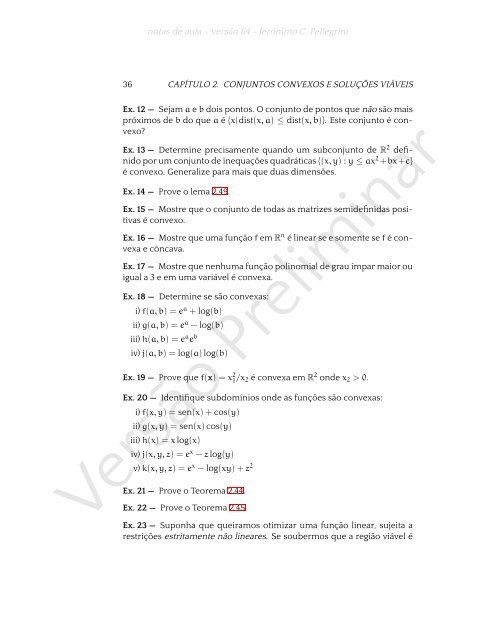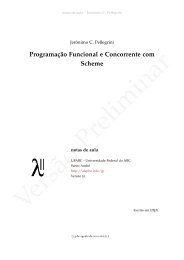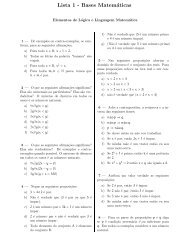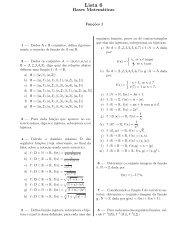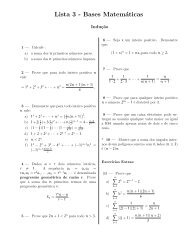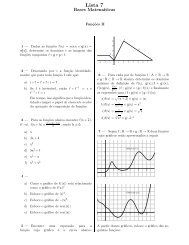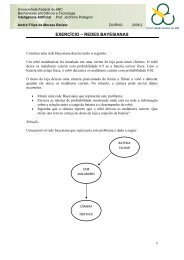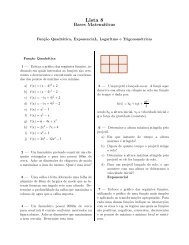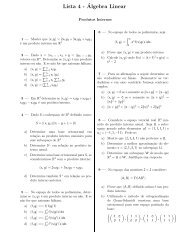Programação Linear (e rudimentos de otimização não-linear)
Programação Linear (e rudimentos de otimização não-linear)
Programação Linear (e rudimentos de otimização não-linear)
You also want an ePaper? Increase the reach of your titles
YUMPU automatically turns print PDFs into web optimized ePapers that Google loves.
notas <strong>de</strong> aula – versão 64 - Jerônimo C. Pellegrini<br />
36 CAPÍTULO 2. CONJUNTOS CONVEXOS E SOLUÇÕES VIÁVEIS<br />
Ex. 12 — Sejam a e b dois pontos. O conjunto <strong>de</strong> pontos que não são mais<br />
próximos <strong>de</strong> b do que a é {x| dist(x, a) ≤ dist(x, b)}. Este conjunto é convexo<br />
Ex. 13 — Determine precisamente quando um subconjunto <strong>de</strong> R 2 <strong>de</strong>finido<br />
por um conjunto <strong>de</strong> inequações quadráticas {(x, y) : y ≤ ax 2 +bx+c}<br />
é convexo. Generalize para mais que duas dimensões.<br />
Ex. 14 — Prove o lema 2.49.<br />
Ex. 15 — Mostre que o conjunto <strong>de</strong> todas as matrizes semi<strong>de</strong>finidas positivas<br />
é convexo.<br />
Ex. 16 — Mostre que uma função f em R n é <strong>linear</strong> se e somente se f é convexa<br />
e côncava.<br />
Ex. 17 — Mostre que nenhuma função polinomial <strong>de</strong> grau ímpar maior ou<br />
igual a 3 e em uma variável é convexa.<br />
Ex. 18 — Determine se são convexas:<br />
i) f(a, b) = e a + log(b)<br />
ii) g(a, b) = e a − log(b)<br />
iii) h(a, b) = e a e b<br />
iv) j(a, b) = log(a) log(b)<br />
Ex. 19 — Prove que f(x) = x 2 1 /x 2 é convexa em R 2 on<strong>de</strong> x 2 > 0.<br />
Ex. 20 — I<strong>de</strong>ntifique subdomínios on<strong>de</strong> as funções são convexas:<br />
i) f(x, y) = sen(x) + cos(y)<br />
ii) g(x, y) = sen(x) cos(y)<br />
iii) h(x) = x log(x)<br />
iv) j(x, y, z) = e x − z log(y)<br />
v) k(x, y, z) = e x − log(xy) + z 2<br />
Versão Preliminar<br />
Ex. 21 — Prove o Teorema 2.44.<br />
Ex. 22 — Prove o Teorema 2.45.<br />
Ex. 23 — Suponha que queiramos otimizar uma função <strong>linear</strong>, sujeita a<br />
restrições estritamente não <strong>linear</strong>es. Se soubermos que a região viável é


